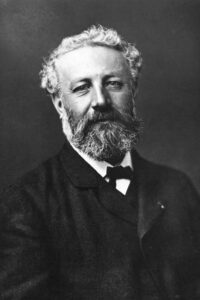
Godfrey Morgan: A Californian Mystery
“An island to sell, for cash, to the highest bidder!” said Dean Felporg, the auctioneer, standing behind his rostrum in the room where the conditions of the singular sale were being noisily discussed.
“Island for sale! Island for sale!” repeated in shrill tones, again and again, Gingrass, the crier, who was threading his way in and out of the excited crowd closely packed inside the immense saloon in the auction mart at No. 10, Sacramento Street.
The crowd consisted not only of a large number of Americans from the States of Utah, Oregon, and California but also of a few Frenchmen, who formed quite a sixth of the population.
Mexicans were there enveloped in their scrapes; Chinamen in their large-sleeved tunics, pointed shoes, and conical hats; one or two Kanucks from the coast; and even a sprinkling of Black Feet, Grosventres, or Flatheads, from the banks of the Trinity river.
The scene is in San Francisco, the capital of California, but not at the period when the placer-mining fever was raging—from 1849 to 1852. San Francisco was no longer what it had been then, a caravanserai, a terminus, an inn, where the busy men who were hastening to the gold fields west of the Sierra Nevada slept for a night. At the end of some twenty years, the old unknown Yerba-Buena had given place to a town unique of its kind, peopled by 100,000 inhabitants, built under the shelter of a couple of hills, away from the shore but stretching off to the farthest heights in the background—a city in short which has dethroned Lima, Santiago, Valparaiso, and every other rival, and which the Americans have made the queen of the Pacific, the “glory of the western coast!”
It was the 15th of May, and the weather was still cold. In California, subject to the direct action of the polar currents, the first weeks of this month are somewhat similar to the last weeks of March in Central Europe. But the cold was hardly noticeable in the thick of the auction crowd. With its incessant clangour, the bell had brought together an enormous crowd, and quite a summer temperature caused the drops of sweat to glisten on the foreheads of the spectators, which the cold outside would soon solidify.
Do not imagine that all these folks had come to the auction room with the intention of buying. I might say that all of them had but come to see. Who would be mad enough, even if he were rich enough, to purchase an isle of the Pacific, which the government had, in some eccentric moment, decided to sell? Would the reserve price ever be reached? Could anybody be found to work up the bidding? If not, it would scarcely be the fault of the public crier, who tried his best to tempt buyers with his shoutings and gestures and the flowery metaphors of his rant. People laughed at him but did not seem much influenced by him.
“An island! An isle to sell!” repeated Gingrass.
“But not to buy!” answered an Irishman whose pocket did not hold enough to pay for a pebble.
“An island which at the valuation will not fetch six dollars an acre!” said the auctioneer.
“And which won’t pay an eighth per cent!” replied a prominent farmer, who was well acquainted with agricultural speculations.
“An isle which measures quite sixty-four miles round and has an area of two hundred and twenty-five thousand acres!”
“Is it solid on its foundation?” asked a Mexican, an old customer at the liquor bars, whose personal solidity seemed rather doubtful.
Read or download Book
Jules Verne
Jules Gabriel Verne (8 February 1828 – 24 March 1905) was a French novelist, poet, and playwright.
Biography.
His collaboration with the publisher Pierre-Jules Hetzel led to the creation of the Voyages Extraordinaires, a series of bestselling adventure novels including Journey to the Center of the Earth (1864), Twenty Thousand Leagues Under the Seas (1870), and Around the World in Eighty Days (1872). His novels, always well documented, are generally set in the second half of the 19th century, considering the technological advances of the time.
In addition to his novels, he wrote numerous plays, short stories, autobiographical accounts, poetry, songs, and scientific, artistic, and literary studies. His work has been adapted for film and television since the beginning of cinema and for comic books, theatre, opera, music, and video games.
Verne is considered an essential author in France and most of Europe, where he has greatly influenced the literary avant-garde and surrealism. His reputation was markedly different in the Anglosphere, where he had often been labelled a writer of genre fiction or children’s books, mainly because of the highly abridged and altered translations in which his novels have frequently been printed. Since the 1980s, his literary reputation has improved.
Since 1979, Jules Verne has been the second most translated author in the world, ranking below Agatha Christie and above William Shakespeare. He has sometimes been called the “father of science fiction,” a title that has also been given to H. G. Wells and Hugo Gernsback. In the 2010s, he was the most translated French author in the world. In France, 2005 was declared “Jules Verne Year” on the occasion of the centenary of the writer’s death.
Life
Early life
Verne was born on 8 February 1828, on Île Feydeau, a then small artificial island on the river Loire within the town of Nantes (later filled-in and incorporated into the surrounding land area), in No. 4 Rue Olivier-de-Clisson, the house of his maternal grandmother Dame Sophie Marie Adélaïde Julienne Allotte de La Fuÿe (born Guillochet de La Perrière). His parents were Pierre Verne, an attorney originally from Provins, and Sophie Allotte de La Fuÿe, a Nantes woman from a local family of navigators and shipowners of distant Scottish descent. In 1829, the Verne family moved some hundred meters away to No. 2 Quai Jean-Bart, where Verne’s brother Paul was born the same year. Three sisters, Anne “Anna” (1836), Mathilde (1839), and Marie (1842) would follow.
In 1834, at six, Verne was sent to boarding school at 5 Place du Bouffay in Nantes. The teacher, Madame Sambin, was the widow of a naval captain who had disappeared some 30 years before. Madame Sambin often told the students that her husband was a shipwrecked castaway and that he would eventually return like Robinson Crusoe from his desert island paradise. The theme of the robinsonade would stay with Verne throughout his life and appear in many of his novels, some of which include The Mysterious Island (1874), Second Fatherland (1900), and The School for Robinsons (1882).
In 1836, Verne went on to École Saint‑Stanislas, a Catholic school suiting the pious religious tastes of his father. Verne quickly distinguished himself in mémoire (recitation from memory), geography, Greek, Latin, and singing. In the same year, 1836, Pierre Verne bought a vacation house at 29 Rue des Réformés in the village of Chantenay (now part of Nantes) on the Loire. In his brief memoir Souvenirs d’enfance et de jeunesse (Memories of Childhood and Youth, 1890), Verne recalled a deep fascination with the river and with the many merchant vessels navigating it. He also took vacations at Brains, in the house of his uncle Prudent Allotte, a retired shipowner who had gone around the world and served as mayor of Brains from 1828 to 1837. Verne took joy in playing interminable rounds of the Game of the Goose with his uncle, and both the game and his uncle’s name would be memorialized in two late novels (The Will of an Eccentric (1900) and Robur the Conqueror (1886), respectively).
Literary debut
Thanks to his visits to salons, Verne came into contact with Alexandre Dumas in 1849 through the mutual acquaintance of a celebrated chirologist of the time, the Chevalier d’Arpentigny. Verne became close friends with Dumas’ son, Alexandre Dumas Fils, and showed him a manuscript for a stage comedy, Les Pailles rompues (The Broken Straws). The two young men revised the play together. Through arrangements with his father, Dumas had it produced by the Opéra-National at the Théâtre Historique in Paris, opening on 12 June 1850.
In 1851, Verne met with a fellow writer from Nantes, Pierre-Michel-François Chevalier (known as “Pitre-Chevalier”), the editor-in-chief of the magazine Musée des familles (The Family Museum). Pitre-Chevalier was looking for articles about geography, history, science, and technology and was keen to ensure that the educational component would be accessible to large popular audiences using a straightforward prose style or an engaging fictional story. With his delight in diligent research, especially in geography, Verne was a natural for the job. Verne first offered him a short historical adventure story, The First Ships of the Mexican Navy, written in the style of James Fenimore Cooper, whose novels had deeply influenced him. Pitre-Chevalier published it in July 1851, and in the same year published a second short story by Verne, A Voyage in a Balloon (August 1851). With its adventurous narrative, travel themes, and detailed historical research, Verne would later describe the latter as “the first indication of the line of novel that I was destined to follow.”
Dumas fils put Verne in contact with Jules Seveste, a stage director who had taken over the directorship of the Théâtre Historique and renamed it the Théâtre Lyrique. Seveste offered Verne the job of theatre secretary with little or no salary attached. Verne accepted, using the opportunity to write and produce several comic operas in collaboration with Hignard and the prolific librettist Michel Carré. To celebrate his employment at the Théâtre Lyrique, Verne joined ten friends to find a bachelors’ dining club, the Onze-sans-femme (Eleven Bachelors).






